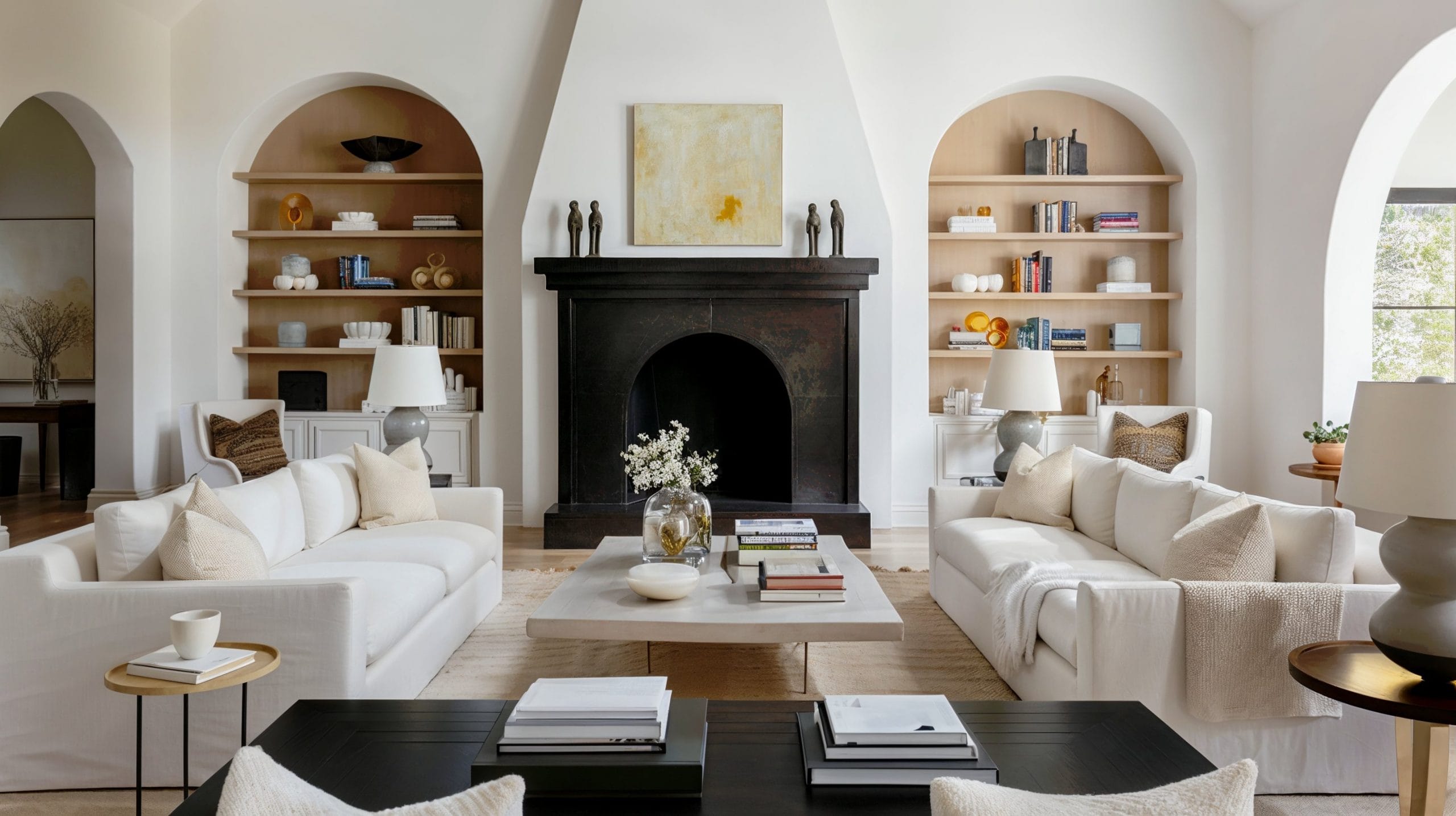Minimalist Interior Design That Maximizes Space and Style a well-executed minimalist interior design ethos can transform even the most modest footprint into an oasis of tranquility and panache. Stripped of superfluous ornamentation, minimalist spaces breathe, offering visual respite amid the clamor of modern life. Yet minimalism is far more than empty rooms and stark palettes. It’s an intentional choreography of light, form, and function—an artful fusion that amplifies spatial perception while exuding effortless sophistication.
This guide delves into the principles and practices that will help you master minimalist interior design, maximizing both square footage and aesthetic allure. Through a synthesis of innovative strategies—ranging from negative-space utilization to integrated storage—discover how to craft an environment that feels expansive, serene, and uniquely yours.

Embracing Negative Space
Negative space, often called “white space” in visual arts, is the silent partner in any minimalist interior design. It is the deliberate absence that bestows prominence upon what remains.
- The Power of Breathing Room
Allowing areas of emptiness around key elements—whether it’s a low-slung sofa or a sculptural floor lamp—elevates their impact. Human perception instinctively gravitates toward objects that sit serenely within uncluttered zones. - Visual Hierarchy Through Void
Negative space establishes a hierarchy of attention. By surrounding a piece of furniture or artwork with air and light, you sculpt a focal point without adding physical bulk. - Spatial Illusion
Emptiness can trick the eye into perceiving a larger area. Low-profile furnishings accentuated by bare expanses foster a sense of perpetual openness, making micro-apartments feel airy and expansive.
Strategic Furniture Selection
Choosing the right pieces is pivotal for minimalist interior design that feels both curated and capacious.
- Low-Profile Silhouettes
Opt for furniture with streamlined profiles—think cantilevered sofas, slim legs, and open bases. These designs minimize visual weight, letting flooring and negative spaces shine through. - Multi-Functional Forms
A minimalist ethos embraces ingenuity. Select items that serve dual purposes: a bench that conceals storage, a coffee table that lifts into a work desk, or a daybed that doubles as guest accommodation. - Sculptural Statements
A single piece with a distinctive form—like an angular armchair or an asymmetrical console—can replace an ensemble of smaller items. One well-chosen object commands attention while reducing clutter.
Monochromatic Palette with Accent Contrasts
Color in minimalist interior design is not an afterthought but a deliberate tool for amplifying space and mood.
- Anchoring Neutrals
Whites, beiges, and soft grays form the foundational canvas. Their reflectivity enhances natural light, while tonal continuity across walls, ceilings, and large furnishings fosters cohesion. - Strategic Pops of Hue
Introduce a solitary accent—perhaps a cerulean throw pillow or a saffron ceramic vase. This punctuating tone activates the environment without fracturing the minimalist narrative. - Textural Nuance
Monochrome need not equate to monotony. Vary finish—matte plaster walls juxtaposed with glossy lacquered cabinets—or layer fabrics (linen, wool, bouclé) to lend subtle depth.
Multi-Functional & Modular Furnishings
Space efficiency is the hallmark of minimalist interior design that maximizes utility.
- Modular Sofas
Sections that shift, detach, or reconfigure grant flexibility for evolving needs—movie nights, impromptu gatherings, or serene lounging. - Hidden-Extend Tables
Wall-mounted drop-leaf tables or telescoping dining sets appear discrete when not in use, then blossom into full functionality at mealtimes. - Convertible Beds
Murphy beds with integrated shelving or sofas that fold out into beds reclaim precious floor area during daylight hours. Clever mechanical engineering underpins seamless transformations.
Integrated Storage Solutions
Clutter is the antithesis of minimalist interior design. Ensuring every object has its place is crucial.
- Concealed Cabinets
Floor-to-ceiling panels that open into storage banks blend invisibly with walls. Handle-less push-latch doors enhance the seamless effect. - Under-Floor Drawers
Raised platforms and shallow subfloor niches can harbor seasonal items, linens, or seldom-used kitchenware, leaving surfaces pristine. - Floating Shelves with Inset Lighting
Recessed shelving carved into walls, illuminated by discreet LED strips, keeps belongings off counters while adding a soft glow.
Textural Layering in a Minimalist Scheme
Minimalism thrives on tactile contrast rather than visual clutter.
- Natural Fibers
A jute rug beneath a leather lounge chair, or a knitted wool throw atop a smooth linen sofa, introduces warmth and tactility. - Stone and Metal Pairings
Cool stone countertops juxtaposed with brushed-brass hardware create an elegant interplay. The solidity of marble or granite balances the airiness of white-painted cabinetry. - Organic Imperfections
Embrace wood grains, uneven concrete finishes, and hand-applied plaster textures to avoid a sterile aesthetic. These nuances root the space in authenticity.
Architectural Lighting Techniques
Light is the linchpin of any minimalist interior design that feels alive and expansive.
- Cove and Recessed Lighting
Indirect illumination washes ceilings and upper walls, erasing harsh shadows and visually lifting the room’s perimeter. - Track Lighting with Adjustable Heads
Slim-profile tracks mounted along structural beams or ceiling coves offer task illumination where needed, while disappearing into the background. - Statement Pendants
One oversized pendant over a dining table or entryway can serve as a sculptural anchor, requiring no additional décor.
Focal Points and Sculptural Accents
A minimalist interior remains dynamic through judicious focalization.
- Single Art Piece
A large-scale abstract painting or a three-dimensional metal wall sculpture creates drama without overcrowding. - Architectural Niches
Carve alcoves into walls to showcase a ceramic vessel or a bonsai tree. Highlight with inset spotlights for gallery-like reverence. - Accent Walls
One wall clad in reclaimed wood, textured plaster, or vertical slats introduces a tactile focal point that coexists with simplicity.
Harmonizing Indoor–Outdoor Flow
Blurring the boundary between inside and out exponentially expands perceived space.
- Floor-to-Ceiling Glazing
Sliding glass doors or fixed panes that open to a patio or balcony invite natural light and vistas, instantly broadening interior confines. - Unified Flooring
Continuing the same tile or polished concrete from indoors to an adjacent terrace creates a seamless datum. - Subdued Transitional Elements
Minimalist screens or bamboo curtains can modulate privacy without obstructing the visual continuum.
Curated Accessory Selection to Maintain Restraint
Accessories breathe personality into minimalist interior design, but must be chosen sparingly.
- One or Two Greenery Specimens
A sculptural yucca plant in a simple planter or a single orchid perched on a side table suffuses life without encumbering the scheme. - Quality Over Quantity
Invest in a limited number of heirloom-quality items—a hand-thrown ceramic bowl, a bespoke terrazzo tray—rather than an array of mass-produced trinkets. - Rotational Displays
Rotate small objects seasonally, storing extras out of sight to keep surfaces uncluttered and refresh visual interest.
The Psychology of Minimalism
Beyond aesthetics, minimalist interior design fosters mental clarity and well-being.
- Reduced Decision Fatigue
A pared environment simplifies choice—what to wear, where to sit, or how to configure a room—liberating cognitive bandwidth for creativity. - Mindful Presence
Unencumbered spaces invite contemplative stillness, encouraging inhabitants to appreciate light shifts, shadows, and subtle textural details. - Stress Reduction
Studies correlate orderly, spacious interiors with lower cortisol levels and improved focus. Minimalist homes can thus become sanctuaries of calm.
Implementing Minimalist Design on a Budget
Minimalism need not be costly. Resourcefulness can yield high-impact results.
- DIY Plaster Finishes
Create nuanced wall textures with off-the-shelf plaster and simple tools, then paint them in matte neutrals. - Upcycling and Refurbishment
Sand and repaint a thrifted sideboard, replacing bulky hardware with sleek brass pulls. - Focused Purchases
Allocate budget to transformative items—luxury lighting or a plush area rug—while economizing on everyday pieces like basic stools or floating shelves.
Minimalist interior design is an exercise in purposeful subtraction and strategic refinement. By embracing negative space, selecting multifunctional furnishings, layering textures, and harnessing architectural lighting, you can craft environments that feel spacious, serene, and supremely stylish. Whether you inhabit a micro-studio or a sprawling loft, these principles unlock the potential of every square inch. The result: a home that breathes, inspires, and offers a daily retreat from a chaotic world—elegantly distilled to its essential beauty.





More Stories
Modern Interior Design Ideas That Will Transform Your Space
How Do House Auctions Work? A Complete Guide
Moroccan Architecture and Interior Design